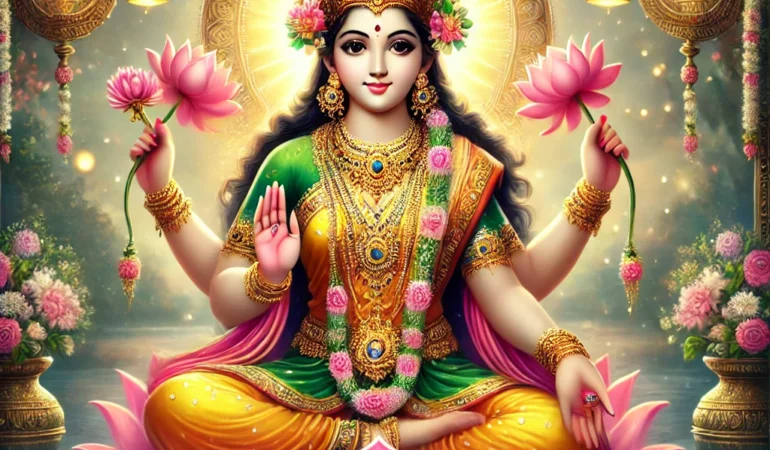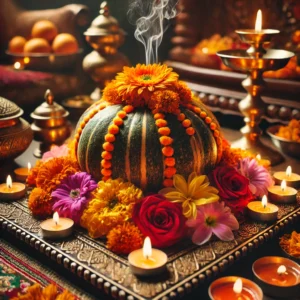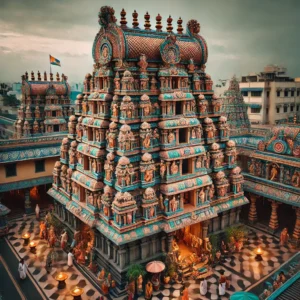
October 19, 2024
The period from Sharad Poornima to Deepawali is considered particularly auspicious for worshippers of Devi Lakshmi, the goddess of wealth across India. This sacred period not only celebrates the goddess of wealth and prosperity, Mahalakshmi, but also symbolizes a deeper connection between devotion, spirituality, and the cycles of nature. The mythology surrounding the Mahalakshmi Temple in Kolhapur, certainly offers lesser known nuances about her significance and helps a devotee to uncover the traditions and rituals that honor the divine feminine during this auspicious time.

The Sacred Mahalakshmi Temple: A Pilgrimage Destination
The Mahalakshmi Temple in Kolhapur, also known as Shri Kshetra Karveer, is a significant pilgrimage site revered for its rich mythology and spiritual essence. This temple venerates the goddess Mahalakshmi (Ambabai), who embodies not only prosperity and abundance but also the essence of divine feminine energy, known as Shakti. The narratives surrounding this sacred space resonate deeply with the spiritual journeys of countless devotees, reflecting the multifaceted nature of Hindu belief.

In Shri Kshetra Karveer, the reverence for goddess Mahalakshmi is rooted in the belief that this site is her cherished abode. Here, the supreme power manifests in three divine forms: Mahakali, Mahalakshmi, and Mahasaraswati. According to the Markandeya Purana, after the universe was formed, Lord Vishnu created two significant locations: Kashi and Karveer. A divine dispute arose between Bhagwan Shankar and the supreme goddess regarding the supremacy of these two sacred places. Ultimately, Lord Vishnu determined that Karveer held greater significance, as it promised both Bhukti (prosperity) and Mukti (liberation).

The interplay between Kashi and Karveer during this time reflects the need for harmony between material pursuits and spiritual growth, a recurring theme in Hindu teachings beautifully encapsulated in the Bhagavad Gita:
“कर्मण्येवाधिकारस्ते मा फलेषु कदाचन,
मा कर्मफलहेतुर्भूर्मा ते सङ्गोऽस्त्वकर्मणि।”
(Translation: “You have the right to perform your prescribed duties, but you are not entitled to the fruits of your actions.”)
The Mythical Origins of Kolhapur

The origins of Kolhapur are steeped in myth, intricately tied to Brahmadev and his three sons: Gay, Lavan, and Kolh. After Gay’s demise in Gaya (symbolizing a place of salvation for ancestors) and Lavan’s in Vidarbha (representing the concept of saltiness in disguise of beauty), Kolh (representing chaos) was sent to confront the formidable demon Keshi (long hair representing lust) at Rakshalaya (abode of protection). After his victorious battle, the demon Kolhasur became the king of the region, signifying the shadow of darkness that often challenges divine forces.
The various manifestations of deities in Kolhapur reflect the omnipresence of divinity, encouraging devotees to see the sacred in every aspect of life. This concept is echoed in the Chandogya Upanishad:
“सर्वं खल्विदं ब्रह्म।”
(Translation: “All this is indeed Brahman.”)

Kolhasur, whose name reflects a connection to ‘Kolh’ (meaning ‘darkness’ or ‘the hidden’), and his wife Kadamba had four sons—each embodying negative traits that terrorized the locals. The sons were:
- Karveerasur: “Karveer” translates to “one who taxes with passion” yet in his demonic form, he represented the potential for abuse of power and the chaos that can arise from greed.
- Vishalasur: Derived from ‘Vishal,’ meaning “vast” or “expansive,” Vishalasur embodied the idea of overwhelming ambition, representing the dangers of excessive desire that can lead to turmoil.
- Kulandhak: From ‘Kula,’ which means “family” or “lineage,” Kulandhak’s name symbolizes the breakdown of familial bonds due to selfishness and strife, manifesting as chaos in society.
- Lajjasur: The name ‘Lajja’ translates to “shame,” indicating the demon’s representation of societal disarray and moral decay that can arise when honor is lost.

In response to the terror inflicted by these demons, Bhagwan Shankar vanquished Karveerasur, restoring order to the region and leading to the name Karveer—a place that would symbolize both the power of light overcoming darkness and the delicate balance of prosperity.
Fueled by rage over the deaths of his sons, Kolhasur prayed to the supreme goddess to withdraw from the region for 100 years, a wish she granted. This divine absence allowed Kolhasur to unleash his torment on the people for a century until the goddess returned, accompanied by divine beings like Kedareshwar (the lord of wealth), Mahargaleshwar (the master of the earth), and Ujjwalaamba (the radiant mother). To protect Karveer, the goddess battled Kolhasur’s four sons, each representing the triumph of divine forces over negativity and chaos:

- Raktalol: From ‘Rakta’ meaning “blood,” this demon symbolizes violence and destruction, thriving on chaos.
- Raktbeej: Literally translating to “blood seed,” Raktbeej represents the endless cycle of negativity that breeds more evil unless stopped.
- Raktaksh: Meaning “blood eye,” this demon embodies the concept of jealousy and envy that can corrupt individuals and society.
- Raktbhoj: From ‘Bhoj’ meaning “feast,” Raktbhoj symbolizes gluttony and excess, demonstrating the dangers of overindulgence.
The internal struggles represented by the battles against Kolhasur and his sons symbolize our own conflicts against negative tendencies such as desire and ego. The Bhagavad Gita addresses this inner conflict:
“उद्धरेदात्मनात्मानं नात्मानमवसादयेत्,
आत्मैव ह्यात्मनो बन्धुरात्मैव रिपुरात्मनः।”
(Translation: “One must elevate, not degrade, oneself. The mind is the friend of the conditioned soul, and his enemy as well.”)

Ultimately, Kolhasur himself challenged the gods, embodying the persistent struggle between good and evil. Impressed by his valor in battle, Bhagwan Shankar granted him a wish. Kolhasur requested to be slain by the goddess Mahalakshmi in her fierce 18-handed form—a symbol of divine strength and feminine power—fulfilled on Ashwin Shuddh Panchami.
In his final moments, Kolhasur expressed a desire for the region to be named after him, establishing it as a holy pilgrimage site akin to Gaya, with a ritual requiring an annual offering of a pumpkin in his honor. Thus, the region became known as Kolhapur, where a pumpkin is sacrificed each year during Kohal Panchami, symbolizing the cycle of destruction and rebirth, and the triumph of light over darkness.Thus, the region became known as Kolhapur, where a pumpkin is sacrificed each year during Kohal Panchami.
Lakshmi Temples Across India

The significance of Lakshmi is celebrated not only in Kolhapur but also in various temples across India, each embodying the essence of prosperity and devotion. It is important to note that all major financial centres of India have some or the other Lakshmi temples, which emerged over last centuries.
· Mahalakshmi Temple, Mumbai: Established in the 18th century by a wealthy merchant named Dhakji Dadaji, this temple was built after the idol of the goddess was discovered along the coastline. As one of Mumbai’s key spiritual sites, it attracts thousands of devotees seeking blessings for prosperity and success. Over the years, the temple has become a focal point for the local community, fostering a sense of togetherness and faith among worshippers. Its stunning traditional architecture, overlooking the Arabian Sea, further enhances its allure.
· Bhagyalakshmi Temple, Hyderabad: Founded in the 16th century, the Bhagyalakshmi Temple was built near the iconic Charminar by local devotees who sought a place to honor the goddess of prosperity. This modest sanctuary has woven itself into the cultural fabric of Hyderabad, formerly known as BhagyaNagar. The temple has evolved into a vibrant community hub, where local families gather for worship and celebrate festivals, reinforcing the shared values of devotion and cultural heritage.

· Mahalakshmi Temple, Chennai: Established in 1976 by a group of devoted individuals led by Pattabhiraman and inspired by their faith in Goddess Lakshmi, this temple uniquely showcases the eight forms of the goddess, each representing different facets of wealth and abundance. It serves as a vibrant hub for community engagement and festivals, highlighting the deep-rooted reverence for Lakshmi among Chennai’s residents, coming together at Elliot’s beah off Bay of Bengal.
· Mahalakshmi Temple, Chattarpur, NCR: Founded in the early 1990s by Swami Dhirendra Brahmachari, this temple merges modern design with traditional devotion. It has become a significant landmark in the National Capital Region, attracting visitors from various backgrounds. The temple has evolved into a center for spiritual awareness and community gatherings, promoting a sense of belonging and faith among its diverse visitors.
The Rituals of Lakshmi Puja: From Sharad Poornima to Deepawali

Sharad Poornima, marking the night of the full moon symbolizes the beginning of auspicious period leading to Deepawali, when devotees prepare to honor Goddess Lakshmi. In the Bengal region, Lakshmi Puja Vrata are performed in many households every Thursday considered auspicious Kojagari Purnima (কোজাগরী পূর্ণিমা), also known as Sharad Purnima or Kumar Purnima, signifies the end of the monsoon season. On this sacred night, it is believed that Goddess Lakshmi roams the earth asking, “Ko Jagarti?”—meaning ‘Who is awake?’ in Sanskrit. Those who remain awake are blessed by the goddess with fortune and wealth.
To welcome Lakshmi, devotees offer her Kheer, Khichuri, or Puri bhog, often fasting until midnight. This practice, known as Kojagara Vrat, is celebrated with enthusiasm, particularly among Bengali women, who create intricate Alpana designs and footprints of the goddess using rice paste or ‘khari mati’ (white clay).
The Deeper Significance of Lakshmi Puja

These rituals surrounding Lakshmi Puja from Kohal Panchami, Kojagiri Vrat or Deepawali emphasize the significance of wealth, prosperity, and the nurturing qualities of the divine feminine. Each act of devotion during this period reinforces the understanding that material wealth is best complemented by spiritual growth. The goddess Mahalakshmi symbolizes Shakti, the divine energy that underpins creation, sustenance, and transformation. Her presence emphasizes the importance of recognizing the feminine aspect of divinity, a fundamental aspect of Hindu philosophy.
As expressed in the Devi Bhagavata Purana:
“या देवी सर्वभूतेषु शक्ति रूपेण संस्थिता,
नमस्तस्यै, नमस्तस्यै, नमस्तस्यै, नमो नमः।”
(Translation: “To the Goddess who resides in all beings in the form of power, we bow down to her.”)
Honoring the Goddess

The rituals and offerings during this sacred period serve as a reminder of the importance of humility, gratitude, and the pursuit of balance in our lives. The annual pumpkin offering during Kohal Panchami , or the fasts during Kojagiri Poornima , or festive ShreeVidhya Upaasana during Deepawali highlights the significance of rituals in Hindu tradition, emphasizing self-surrender and the cleansing of negative energies. The Rig Veda beautifully encapsulates this idea:
“यज्ञेन दानं एतेन,
यज्ञ धर्मं पश्यामः।”
(Translation: “By sacrifice, we attain the divine; thus, we see the divine nature of dharma.”)
Conclusion
The story of the Mahalakshmi Temple and the practices surrounding Lakshmi Puja invite us on an inner spiritual journey, encouraging us to explore the interplay of light and darkness within ourselves. Each character and event serves as a metaphor for our experiences, teaching us that true prosperity and liberation arise from embracing the complexities of life with awareness and devotion.

As we celebrate Lakshmi Puja from Sharad Poornima to Deepawali, let us honor the goddess Mahalakshmi and cultivate inner harmony, leading to a life filled with fulfillment and spiritual richness. By integrating the teachings of foundational texts and participating in the vibrant rituals across various temples, we can connect more profoundly with our spiritual heritage and the timeless wisdom they offer.
This sacred journey of honoring Mahalakshmi in Kolhapur and across India serves as a reminder of the divine’s presence in our lives and the blessings that come from understanding and embracing the richness of our traditions.
JaYaTu MaHaaLakshmi

